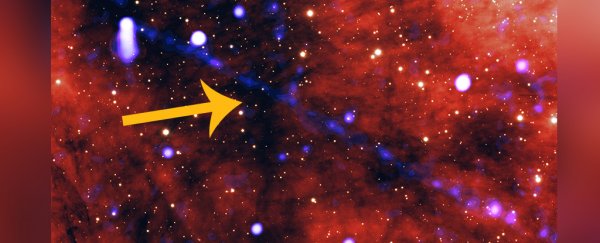A runaway dead star zooming through space at breakneck speeds has left behind a huge trail of matter and antimatter particles.
The star is a pulsar called PSR J2030+4415 or J2030 for short; it's around 20 kilometers (12 miles) in diameter, and it's speeding through space at a breakneck velocity of around 450 kilometers per second (about a million miles per hour).
This set of features has led to the star's enormous, comet-like tail of particles, extending for 7 light-years across interstellar space.
Those particles are matter (electrons) and antimatter (positrons), seen in a new image from the Chandra X-ray Observatory, and they could help scientists figure out why there seems to be more antimatter in the Milky Way than predictions say there should be.
 J2030 in X-ray and optical. (X-ray: NASA/CXC/Stanford Univ./M. de Vries; Optical: NSF/AURA/Gemini Consortium)
J2030 in X-ray and optical. (X-ray: NASA/CXC/Stanford Univ./M. de Vries; Optical: NSF/AURA/Gemini Consortium)
Pulsars are a type of neutron star, the collapsed cores of stars that had a main sequence mass between about 8 and 30 times that of the Sun.
These stars are super dense, with powerful magnetic fields. A pulsar adds a high rotation rate to the mix; J2030 spins about three times a second, and that's not even close to as fast as these things can go.
Pulsars emit winds of charged particles that are usually confined by their magnetic field.
Because J2030 is speeding through space, its wind is trailing along behind it. Ahead of it is a bow shock, close to an interstellar magnetic field line. Two or three decades ago, the bow shock seems to have slowed down, which means the star caught up with and punched through it.
 Full length of the filament. (NASA/CXC/Stanford Univ./M. de Vries)
Full length of the filament. (NASA/CXC/Stanford Univ./M. de Vries)
"This likely triggered a particle leak," explained astronomer Roger Romani of Stanford University.
"The pulsar wind's magnetic field linked up with the interstellar magnetic field, and the high-energy electrons and positrons squirted out through a nozzle formed by connection."
The particles leaking out of the pulsar wind seem to have been accelerated along this interstellar magnetic field line to speeds about a third of the speed of light. This causes the beam to glow brightly in X-rays, as you can see above.
A new paper on the phenomenon has been accepted by The Astrophysical Journal, and is available on preprint server arXiv. You can also download a high-resolution image of the beam on the Chandra website.
